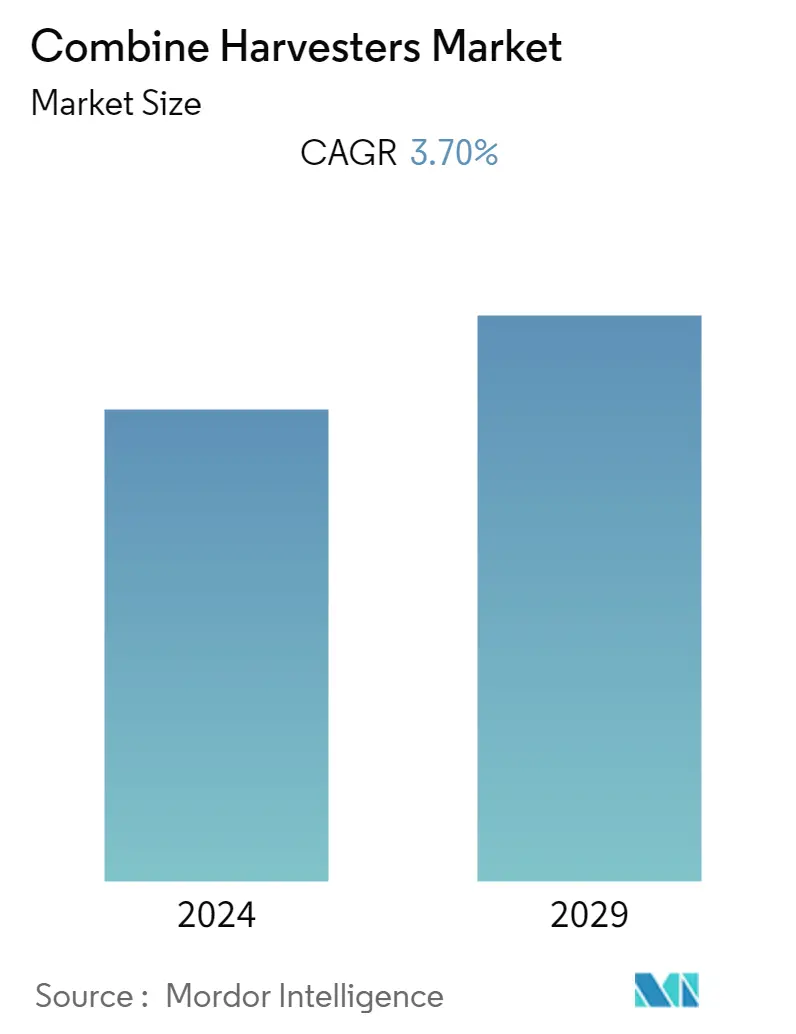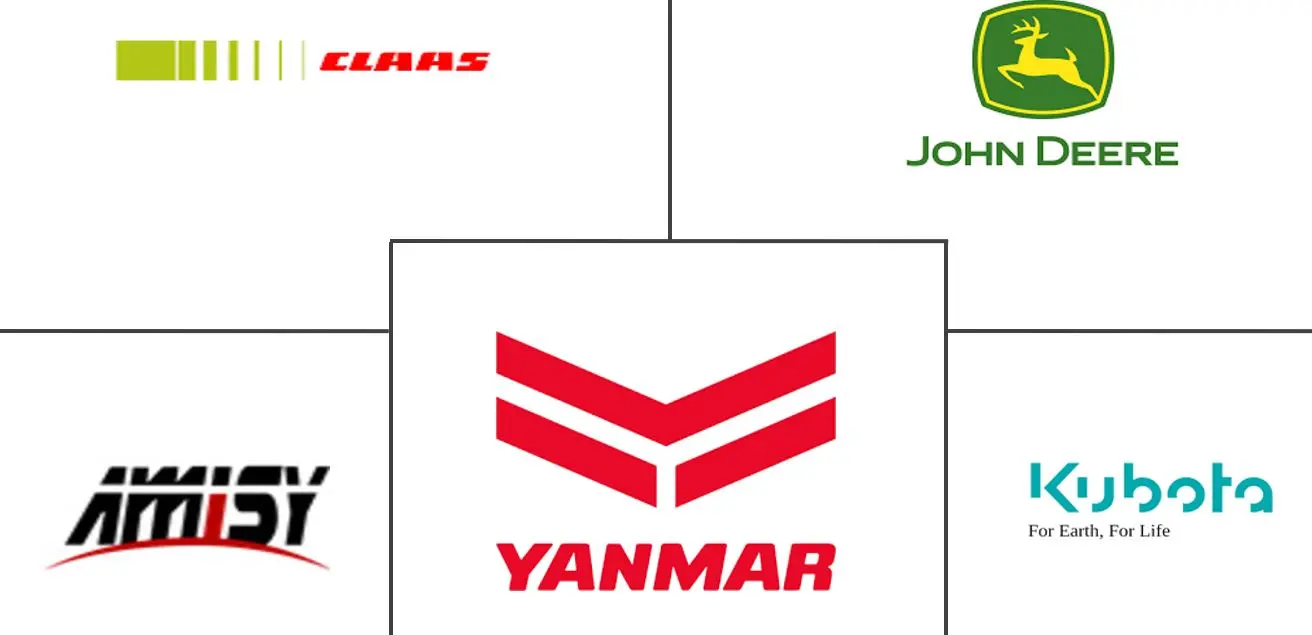Market Size of Combine Harvesters Industry

| Study Period | 2019 - 2029 |
| Base Year For Estimation | 2023 |
| CAGR | 3.70 % |
| Fastest Growing Market | Asia Pacific |
| Largest Market | North America |
| Market Concentration | High |
Major Players
*Disclaimer: Major Players sorted in no particular order |
Combine Harvester Market Analysis
The combined harvesters market is projected to register a CAGR of 3.7% during the forecast period.
- Increasing farm mechanization is one of the most important reasons behind the growth of the combined harvesters market. Farm mechanization saves time and labor, cuts down crop production costs in the long run, reduces post-harvest losses, and boosts crop output and farm income. Steady growth was observed in manually operated tools, animal-operated implements, and equipment operated by mechanical and electrical power sources.
- Agricultural systems worldwide have undergone changes in the cropping system, the type of power sources used, and the application of inputs to achieve a high level of productivity. The concerns about increasing the productivity of farms with declining labor availability are mainly driving the market. The favorable credit policies toward machinery purchases adopted by the government and other institutions, coupled with the ability to increase farm productivity, are driving the market's growth.
- Asian countries like India, China, and Japan are urging farmers to adopt the latest technologies to enhance productivity. China and Japan are moving toward autonomous farms in the upcoming years. Hence, the major players in the country are investing in developing advanced combine harvesters.
Combine Harvester Industry Segmentation
Combined harvesters are important in achieving automation and mechanization in the field of agriculture. The combine harvesters market is segmented by type (self-propelled, tractor-pulled combine, and PTO-powered combine) and geography (North America, Europe, Asia-Pacific, South America, and Africa). The report offers market size and forecasts in terms of value in USD million for all the above segments.
| Type | |
| Self-propelled | |
| Tractor-pulled Combine | |
| PTO-powered Combine |
| Geography | ||||||||
| ||||||||
| ||||||||
| ||||||||
| ||||||||
|
Combine Harvesters Market Size Summary
The combined harvesters market is experiencing growth driven by the increasing mechanization of farms, which enhances productivity and reduces labor costs. This trend is particularly evident in regions facing labor shortages due to urbanization and industrialization, prompting farmers to adopt more efficient machinery. Governments and institutions are supporting this shift through favorable credit policies, further boosting the market. In Asia, countries like India, China, and Japan are encouraging the adoption of advanced technologies, with China and Japan moving towards autonomous farming solutions. This has led to significant investments by major players in developing sophisticated combine harvesters to meet the rising demand.
In North America, the scarcity of labor and rising labor costs are pushing the region towards adopting new technologies to improve agricultural efficiency. The United States, a key player in this market, is witnessing a notable increase in the sale of self-propelled combined harvesters, reflecting a broader trend of mechanization in agriculture. The market is consolidated with major companies such as CLAAS, John Deere, Yanmar Co. Ltd, and Kubota Agricultural Machinery, which are expanding their production capacities and investing in innovation to cater to the growing demand. These companies are also engaging in strategic partnerships and acquisitions to enhance their market presence and drive technological advancements in combined harvesters.
Combine Harvesters Market Size - Table of Contents
-
1. MARKET DYNAMICS
-
1.1 Market Overview
-
1.2 Market Drivers
-
1.3 Market Restraints
-
1.4 Porter's Five Forces Analysis
-
1.4.1 Bargaining Power of Suppliers
-
1.4.2 Bargaining Power of Buyers/Consumers
-
1.4.3 Threat of New Entrants
-
1.4.4 Threat of Substitute Products
-
1.4.5 Intensity of Competitive Rivalry
-
-
-
2. MARKET SEGMENTATION
-
2.1 Type
-
2.1.1 Self-propelled
-
2.1.2 Tractor-pulled Combine
-
2.1.3 PTO-powered Combine
-
-
2.2 Geography
-
2.2.1 North America
-
2.2.1.1 United States
-
2.2.1.2 Canada
-
2.2.1.3 Mexico
-
2.2.1.4 Rest of North America
-
-
2.2.2 Europe
-
2.2.2.1 Germany
-
2.2.2.2 United Kingdom
-
2.2.2.3 France
-
2.2.2.4 Spain
-
2.2.2.5 Italy
-
2.2.2.6 Rest of Europe
-
-
2.2.3 Asia-Pacific
-
2.2.3.1 China
-
2.2.3.2 Japan
-
2.2.3.3 India
-
2.2.3.4 Australia
-
2.2.3.5 Rest of Asia-Pacific
-
-
2.2.4 South America
-
2.2.4.1 Brazil
-
2.2.4.2 Argentina
-
2.2.4.3 Rest of South America
-
-
2.2.5 Africa
-
2.2.5.1 South Africa
-
2.2.5.2 Rest of Africa
-
-
-
Combine Harvesters Market Size FAQs
What is the current Combine Harvesters Market size?
The Combine Harvesters Market is projected to register a CAGR of 3.70% during the forecast period (2024-2029)
Who are the key players in Combine Harvesters Market?
CLAAS, John Deere, Zhengzhou Amisy Machinery Co. Ltd, Yanmar Co. Ltd and Kubota Agricultural Machinery are the major companies operating in the Combine Harvesters Market.

